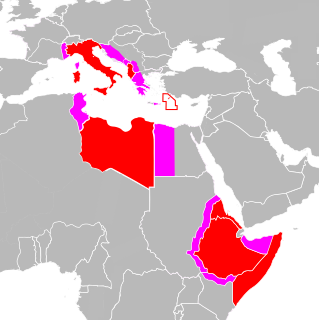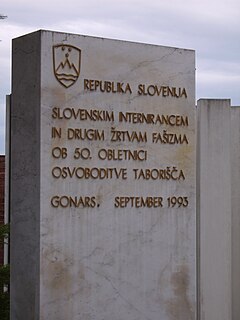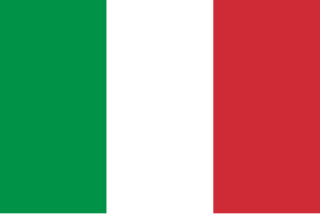 W
WThe participation of Italy in the Second World War was characterized by a complex framework of ideology, politics, and diplomacy, while its military actions were often heavily influenced by external factors. Italy joined the war as one of the Axis Powers in 1940, as the French Third Republic surrendered, with a plan to concentrate Italian forces on a major offensive against the British Empire in Africa and the Middle East, known as the "parallel war", while expecting the collapse of British forces in the European theatre. The Italians bombed Mandatory Palestine, invaded Egypt and occupied British Somaliland with initial success. However, German and Japanese actions in 1941 led to the entry of the Soviet Union and United States, respectively, into the war, thus ruining the Italian plan of forcing Britain to agree to a negotiated peace settlement.
 W
WThe bombing of Rome in World War II took place on several occasions in 1943 and 1944, primarily by Allied and to a smaller degree by Axis aircraft, before the city was invaded by the Allies on June 4, 1944. Pope Pius XII was initially unsuccessful in attempting to have Rome declared an open city, through negotiations with President Roosevelt via Archbishop Francis Spellman. Rome was eventually declared an open city on August 14, 1943 by the defending forces.
 W
WThe bombing of Zadar during the Second World War by the Allies lasted from November 1943 to October 1944. Although other large cities in Italy were also bombed, the bombing of Zadar stands out because of the number of attacks and the number of fatalities. Reports vary greatly; the Allies documented 30 bombing raids, while contemporary Italian accounts claim 54. Fatalities recorded range from under 1,000 to as many as 4,000 of the city's 20,000 inhabitants.
 W
WBorgo San Dalmazzo was an internment camp operated by Nazi Germany in Borgo San Dalmazzo, Piedmont, Italy.
 W
WCampagna internment camp, located in Campagna, a town near Salerno in Southern Italy, was an internment camp for Jews and foreigners established by Benito Mussolini in 1940.
 W
WThe internment camp in Casoli, in the province of Chieti, was one of several internment camps set up by the fascist government following the entry of Italy into World War II, to sit foreigners and anti-fascists. It operated from July 1940 to September 1943, with a capacity of 80-90 people. Jewish refugees from Germany and Austria were interned first, then "ex-Yugoslavs".
 W
WCorropoli internment camp, in the province of Teramo, was one of several internment camps set up by the fascist government following the entry of Italy into World War II, to sit foreigners and anti-fascists. It operated from January 1941 to May 1944, with a maximum capacity of 150 people. Irredentist Slavic and Italian communists were interned and after September 8, 1943 it also served as a concentration camp for Jews.
 W
WThe Fossoli camp was an internment camp in Italy, established during World War II and located in the village Fossoli, Carpi, Emilia-Romagna. It began as a prisoner of war camp in 1942, later being a Jewish concentration camp, then a police and transit camp, a labour collection centre for Germany and, finally, a refugee camp, before closing in 1970.
 W
WThe Gonars concentration camp was one of the several Italian concentration camps and it was established on February 23, 1942, near Gonars, Italy.
 W
WItalian Ethiopia, also known as the Italian Empire of Ethiopia, was an Italian formal entity of the territory of the conquered Ethiopian Empire. Italian Ethiopia was not an administrative entity, but the formal name of the former territory of the Ethiopian Empire which now constituted the Governorates of Amhara, Harar, Galla-Sidamo, and Scioa after the establishment of Italian East Africa.
 W
WThis is a list of the Italy national football team results from 1930 to 1949. During this period, Italy achieved first place at the 1934 and 1938 FIFA World Cup, the gold medal at the 1936 Olympic football tournament, and first place at the 1927–30 and the 1933–35 Central European International Cup as well as coming in second place at the 1931–32 and the 1936–38 editions of the latter tournament.
 W
WThe Kingdom of Italy was a state which existed from 1861 – when King Victor Emmanuel II of Sardinia was proclaimed King of Italy – until 1946, when civil discontent led an institutional referendum to abandon the monarchy and form the modern Italian Republic. The state was founded as a result of the unification of Italy under the influence of the Savoy-led Kingdom of Sardinia, which can be considered its legal predecessor state.
 W
WFascist Italy was the era of National Fascist Party government from 1922 to 1943 with Benito Mussolini as Prime Minister of the Kingdom of Italy. The Italian Fascists imposed totalitarian rule and crushed political and intellectual opposition, while promoting economic modernization, traditional social values and a rapprochement with the Roman Catholic Church. According to Payne (1996), "[the] Fascist government passed through several relatively distinct phases". The first phase (1922–1925) was nominally a continuation of the parliamentary system, albeit with a "legally-organized executive dictatorship". The second phase (1925–1929) was "the construction of the Fascist dictatorship proper". The third phase (1929–1934) was with less activism. The fourth phase (1935–1940) was characterized by an aggressive foreign policy: the Second Italo-Ethiopian War, which was launched from Eritrea and Somaliland; confrontations with the League of Nations, leading to sanctions; growing economic autarky; invasion of Albania; and the signing of the Pact of Steel. The fifth phase (1940–1943) was World War II itself which ended in military defeat, while the sixth and final phase (1943–1945) was the rump Salò Government under German control.
 W
WThe Monigo concentration camp was a prison camp opened during World War II aimed at civilian prisoners. It was located in Monigo, a suburb of the town of Treviso. The camp was active between 1942 and 1943. The total number of inmates is not certain, but is estimated in a total of around 10,000, with an average number of 2,582 prisoners at a time. The camp often surpassed its full capacity of 2,400.
 W
WNereto, in the province of Teramo, was one of several internment camps set up by the fascist government following the entry of Italy into World War II, to sit foreigners and anti-fascists. It operated from July 1940 to February 1944, with a maximum capacity of 160 people. There were Jewish and Slavic refugees interned from the Balkans in this camp.
 W
WRenicci is a village in the municipality of Anghiari, which was the site of a fascist concentration camp for civilians from Yugoslavia, mostly rounded up by Italian troops in Slovenia and in particular in the then Province of Ljubljana. It is estimated that in eleven months of activity, the camp hosted about ten thousand prisoners, 159 of whom lost their lives because of the prohibitive conditions of detention. The remains of most of the victims are kept in the Shrine of the Slavs located within the Sansepolcro cemetery. After decades of neglect, recently in the area where the concentration camp lied, the Renicci Memorial Park was built, and annually hosts the celebrations for the Day of Remembrance.
 W
WServigliano prison camp began as a POW camp for Austrian soldiers of World War I. Following Italy's entry to World War II, the fascist government used it as a concentration camp for civilian and military prisoners between October 1940 to September 1943. The Italian Social Republic later converted it into a deportation camp for Jews between October 1943 and June 1944.
 W
WThe participation of Italy in the Second World War was characterized by a complex framework of ideology, politics, and diplomacy, while its military actions were often heavily influenced by external factors. Italy joined the war as one of the Axis Powers in 1940, as the French Third Republic surrendered, with a plan to concentrate Italian forces on a major offensive against the British Empire in Africa and the Middle East, known as the "parallel war", while expecting the collapse of British forces in the European theatre. The Italians bombed Mandatory Palestine, invaded Egypt and occupied British Somaliland with initial success. However, German and Japanese actions in 1941 led to the entry of the Soviet Union and United States, respectively, into the war, thus ruining the Italian plan of forcing Britain to agree to a negotiated peace settlement.